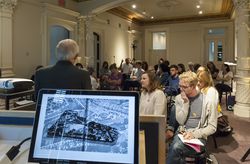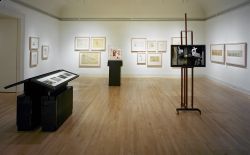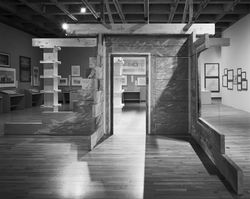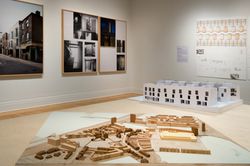PHCON2002:0016:005
Description:
Binder consists of published documentation on the work of Gordon Matta-Clark from the period from 1971 to 1977. It includes exhibition catalogues, reviews of exhibitions, and published interviews; these include documentation on Alternatives to the Washington Square Art Fair (1973) ; Anarchitecture (1973-1974); A W-Hole House (1973); Bingo (1974); City Slivers (1976); Conical Intersect (1975); Contrabienal (1971); Day's End (1975); Fresh Air Cart (1972); Jacks (1971); Jacob's Ladder (1977); Meander (1976); Office Baroque (1977); Open House (1972); Underground Paris (1977); Subway Graffiti (1973); Splitting (1974); Tree Dance (1971); and Walls Paper (1972). Photographs, both personal and those created for publicity, are contained in the binder, as well as correspondence and an example of a Certificate of Authenticity created to give to purchasers of his works. Also included are a series of different resumes written by Matta-Clark along with a more extensive posthumous curriculum vitae and a list of the books in his library. Binder contains photographs, slides and textual records.
1971-1977
Reviews, Announcements, Catalogues & Photos 1970-77
Actions:
PHCON2002:0016:005
Description:
Binder consists of published documentation on the work of Gordon Matta-Clark from the period from 1971 to 1977. It includes exhibition catalogues, reviews of exhibitions, and published interviews; these include documentation on Alternatives to the Washington Square Art Fair (1973) ; Anarchitecture (1973-1974); A W-Hole House (1973); Bingo (1974); City Slivers (1976); Conical Intersect (1975); Contrabienal (1971); Day's End (1975); Fresh Air Cart (1972); Jacks (1971); Jacob's Ladder (1977); Meander (1976); Office Baroque (1977); Open House (1972); Underground Paris (1977); Subway Graffiti (1973); Splitting (1974); Tree Dance (1971); and Walls Paper (1972). Photographs, both personal and those created for publicity, are contained in the binder, as well as correspondence and an example of a Certificate of Authenticity created to give to purchasers of his works. Also included are a series of different resumes written by Matta-Clark along with a more extensive posthumous curriculum vitae and a list of the books in his library. Binder contains photographs, slides and textual records.
1971-1977
The CCA presents Toolkit for Today 2014, a summer seminar held as part of the TD Bank Group-CCA Collection Research Grants program. This year the seminar aims to address questions related to contemporary architecture, showing how projects enrich and diverge from each other and how their differences are born of unusual perspectives and new ways of articulating(...)
23 June 2014 to 28 June 2014
Toolkit for Today: Materials and Atmospheres
Actions:
Description:
The CCA presents Toolkit for Today 2014, a summer seminar held as part of the TD Bank Group-CCA Collection Research Grants program. This year the seminar aims to address questions related to contemporary architecture, showing how projects enrich and diverge from each other and how their differences are born of unusual perspectives and new ways of articulating(...)
The exhibition addresses a central and timely aspect of the work of Carlo Scarpa: its distinctive approach to contending with the layers of history that mark the fabric of a city and a building. In addressing Scarpa’s ability to weave new work into, and often out of, the disparate fragments of the old, Carlo Scarpa, Architect: Intervening with History begins to unravel(...)
Main galleries
26 May 1999 to 31 October 1999
Carlo Scarpa, Architect: Intervening with History
Actions:
Description:
The exhibition addresses a central and timely aspect of the work of Carlo Scarpa: its distinctive approach to contending with the layers of history that mark the fabric of a city and a building. In addressing Scarpa’s ability to weave new work into, and often out of, the disparate fragments of the old, Carlo Scarpa, Architect: Intervening with History begins to unravel(...)
Main galleries
Project
BMI/HQ
AP144.S2.D74
Description:
File documents the unexecuted design for the headquarters of the Birmingham and Midland Institute (BMI), in Birmingham, England. This project is related to the Shantasea Development (AP144.S2.D72) from which Cedric Price resigned as architect to take on the role of architect for BMI, one of the proposed tenants for the Shantasea project. Cedric Price proposed a municipal and regional "nerve centre" to house seminar and study rooms, workshops, galleries, film, television and music studios, a library, a planetarium, and a theatre. A flexible life-cycle plan (expansion, static, contraction) for the building and the activities would allow BMI to expand in the short and medium term, and to shrink in the long term, when it was assumed that many of its roles would be replaced by the UK's Open University plan (Works II, 42). Work on the project came to a stop in 1970 under a new city council (Architectural Design, June 1971, 368). Existing conditions material consists of maps and a survey of Birmingham. Conceptual sketches and drawings include: annotated diagrammatic plans and sections used to develop the building's massing and the horizontal/vertical relationships between functional areas; axonometric views showing the building's general form/functions; plans used for calculating square footage; diagrams showing visual and physical movement through the building; information and movement charts; and flow charts showing the building's organization. Design development drawings consist of graphs showing how functional areas might be used over time. Design development and working drawings include: diagrammatic plans and sections; exploded axonometric views of the functional relationships between areas; exterior axonometric views; sectional perspectives; space allocation plans; circulation drawings; diagrams showing activities throughout the day; furniture equipment schedules; theatre seating and stair studies; and elevations for exterior cladding. Charts show links between activities/actions; activity distribution; activity/capacity; progress of pre-contract work; and the telephone network. File also includes drawings by engineering consultants Felix Samuely and Partners and Zisman, Bowyer and Partners. Presentation material includes: newspaper clippings and text concerning the project; diagrammatic plans, sections, and charts; and a photo collage of the site; and a text by Cedric Price entitled "The Present Position". Some materials in this file were published in "Cedric Price Supplement No. 3", 'Architectural Design', vol. 41, (June 1971), 364-368, and 'Cedric Price-Works II' (London: Architectural Press, 1984), 36, 42. Material in this file was produced between 1967 and 1971. Zisman Bowyer and Partners appear as the mechanical and electrical consulting engineers; Silk and Frazier as the quantity surveyors; and Versa-Serve Ltd as the catering consultants on this project. File contains cartographic materials, conceptual drawings, design development drawings, panels, photographic materials, presentation drawings, presentation panels, publication drawings, technical drawings, and textual records.
1967-1971
BMI/HQ
Actions:
AP144.S2.D74
Description:
File documents the unexecuted design for the headquarters of the Birmingham and Midland Institute (BMI), in Birmingham, England. This project is related to the Shantasea Development (AP144.S2.D72) from which Cedric Price resigned as architect to take on the role of architect for BMI, one of the proposed tenants for the Shantasea project. Cedric Price proposed a municipal and regional "nerve centre" to house seminar and study rooms, workshops, galleries, film, television and music studios, a library, a planetarium, and a theatre. A flexible life-cycle plan (expansion, static, contraction) for the building and the activities would allow BMI to expand in the short and medium term, and to shrink in the long term, when it was assumed that many of its roles would be replaced by the UK's Open University plan (Works II, 42). Work on the project came to a stop in 1970 under a new city council (Architectural Design, June 1971, 368). Existing conditions material consists of maps and a survey of Birmingham. Conceptual sketches and drawings include: annotated diagrammatic plans and sections used to develop the building's massing and the horizontal/vertical relationships between functional areas; axonometric views showing the building's general form/functions; plans used for calculating square footage; diagrams showing visual and physical movement through the building; information and movement charts; and flow charts showing the building's organization. Design development drawings consist of graphs showing how functional areas might be used over time. Design development and working drawings include: diagrammatic plans and sections; exploded axonometric views of the functional relationships between areas; exterior axonometric views; sectional perspectives; space allocation plans; circulation drawings; diagrams showing activities throughout the day; furniture equipment schedules; theatre seating and stair studies; and elevations for exterior cladding. Charts show links between activities/actions; activity distribution; activity/capacity; progress of pre-contract work; and the telephone network. File also includes drawings by engineering consultants Felix Samuely and Partners and Zisman, Bowyer and Partners. Presentation material includes: newspaper clippings and text concerning the project; diagrammatic plans, sections, and charts; and a photo collage of the site; and a text by Cedric Price entitled "The Present Position". Some materials in this file were published in "Cedric Price Supplement No. 3", 'Architectural Design', vol. 41, (June 1971), 364-368, and 'Cedric Price-Works II' (London: Architectural Press, 1984), 36, 42. Material in this file was produced between 1967 and 1971. Zisman Bowyer and Partners appear as the mechanical and electrical consulting engineers; Silk and Frazier as the quantity surveyors; and Versa-Serve Ltd as the catering consultants on this project. File contains cartographic materials, conceptual drawings, design development drawings, panels, photographic materials, presentation drawings, presentation panels, publication drawings, technical drawings, and textual records.
File 74
1967-1971
archives
Level of archival description:
Fonds
Joseph Rykwert fonds
AP209
Synopsis:
The Joseph Rykwert fonds, 1928-2022, documents Joseph Rykwert’s career as an architectural historian, author and professor. The fonds includes the records for over a dozen monographs written between the mid-1960s and the mid-2010s as well as edited works and articles, and details his teaching and lecturing activities from the 1960s onwards in universities in Europe and the United States. The records highlight Joseph Rykwert’s multidisciplinary approach, which involved archaeology, anthropology and psychoanalysis in his study of the history and theory of architecture and of the urban form. The fonds is composed of textual records, publications and ephemera, and of photographs including multiple albums and a large number of slides; the fonds also documents Joseph Rykwert’s career as an independent designer through drawings realized between the late 1940s and the late 1970s.
1928-2022
Joseph Rykwert fonds
Actions:
AP209
Synopsis:
The Joseph Rykwert fonds, 1928-2022, documents Joseph Rykwert’s career as an architectural historian, author and professor. The fonds includes the records for over a dozen monographs written between the mid-1960s and the mid-2010s as well as edited works and articles, and details his teaching and lecturing activities from the 1960s onwards in universities in Europe and the United States. The records highlight Joseph Rykwert’s multidisciplinary approach, which involved archaeology, anthropology and psychoanalysis in his study of the history and theory of architecture and of the urban form. The fonds is composed of textual records, publications and ephemera, and of photographs including multiple albums and a large number of slides; the fonds also documents Joseph Rykwert’s career as an independent designer through drawings realized between the late 1940s and the late 1970s.
archives
Level of archival description:
Fonds
1928-2022
The exhibition presents three aspects of the villas described by the Roman writer, Pliny the Younger, in the first century AD: their direct historical influence on architecture, the indirect influence they have exerted on architects as a model for study, and their impact on the classical tradition in the city of Montreal. The Villas of Pliny and Classical Architecture(...)
Musée des beaux-arts de Montréal
14 October 1983 to 11 December 1983
The Villas of Pliny and Classical Architecture in Montréal
Actions:
Description:
The exhibition presents three aspects of the villas described by the Roman writer, Pliny the Younger, in the first century AD: their direct historical influence on architecture, the indirect influence they have exerted on architects as a model for study, and their impact on the classical tradition in the city of Montreal. The Villas of Pliny and Classical Architecture(...)
Musée des beaux-arts de Montréal
The New Spirit: Modern Architecture in Vancouver, 1938–1963 looks at key buildings and projects from an exhilarating epoch in Vancouver’s history through design drawings, period photographs, furniture, and decoration. In the years following the Second World War, Vancouver emerged as a city with a particularly vital and progressive architectural culture, adapting the(...)
Main galleries
5 March 1997 to 25 May 1997
The New Spirit: Modern Architecture in Vancouver, 1938-1963
Actions:
Description:
The New Spirit: Modern Architecture in Vancouver, 1938–1963 looks at key buildings and projects from an exhilarating epoch in Vancouver’s history through design drawings, period photographs, furniture, and decoration. In the years following the Second World War, Vancouver emerged as a city with a particularly vital and progressive architectural culture, adapting the(...)
Main galleries
archives
Level of archival description:
Fonds
AP196
Synopsis:
Studio Gang Ford Calumet Environmental Center project records, 2003-2012, documents the design process for the Ford Calumet Environmental Center in Chicago, United-States. The records represent both phases during the competition and the full-term design, after the firm won the project. The records consist of born-digital material, sketches and drawings, textual records, photographs and seven models.
2003-2011
Studio Gang Ford Calumet Environmental Center project records
Actions:
AP196
Synopsis:
Studio Gang Ford Calumet Environmental Center project records, 2003-2012, documents the design process for the Ford Calumet Environmental Center in Chicago, United-States. The records represent both phases during the competition and the full-term design, after the firm won the project. The records consist of born-digital material, sketches and drawings, textual records, photographs and seven models.
archives
Level of archival description:
Fonds
2003-2011
As part of the CCA’s ongoing exploration of key issues in contemporary architecture with a specific focus on urban, social, and environmental concerns, Some Ideas on Living in London and Tokyo by Stephen Taylor and Ryue Nishizawa features recent architectural projects that propose new solutions to the challenges of building homes in dense urban environments. London and(...)
Main galleries
14 May 2008 to 26 October 2008
Some Ideas on Living in London and Tokyo by Stephen Taylor and Ryue Nishizawa
Actions:
Description:
As part of the CCA’s ongoing exploration of key issues in contemporary architecture with a specific focus on urban, social, and environmental concerns, Some Ideas on Living in London and Tokyo by Stephen Taylor and Ryue Nishizawa features recent architectural projects that propose new solutions to the challenges of building homes in dense urban environments. London and(...)
Main galleries
archives
Level of archival description:
Fonds
AP106
Synopsis:
The Faubourg Québec project records, 1989-1994, document the redevelopment of Faubourg Québec, a 30 acre site east of the Old Port of Montréal, into an urban residential neighbourhood. Materials in these project records consist of approximately 253 drawings (including reprographic copies) and 0.33 of l.m. textual materials.
1989-1994
Faubourg Québec project records
Actions:
AP106
Synopsis:
The Faubourg Québec project records, 1989-1994, document the redevelopment of Faubourg Québec, a 30 acre site east of the Old Port of Montréal, into an urban residential neighbourhood. Materials in these project records consist of approximately 253 drawings (including reprographic copies) and 0.33 of l.m. textual materials.
archives
Level of archival description:
Fonds
1989-1994




